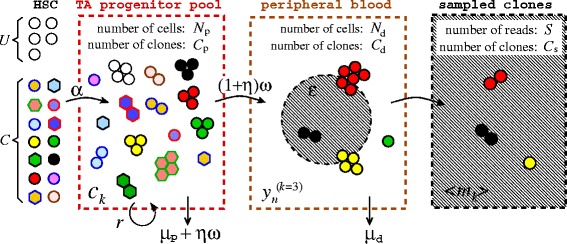Fig. 3.

Schematic of our mathematical model. Of the ∼106– 107 CD34+ cells in the animal immediately after transplantation, C active HSCs are distinctly labeled through lentiviral vector integration. U HSCs are unlabeled because they were not mobilized, escaped lentiviral marking, or survived ablation. All HSCs asymmetrically divide to produce progenitor cells, which in turn replicate with an effective carrying capacity-limited rate r. Transit-amplifying progenitor cells die with rate μ p or terminally differentiate with rate ω. The terminal differentiation of the progenitor cells occurs symmetrically with probability η or asymmetrically with probability 1−η. This results in a combined progenitor-cell removal rate μ=μ p+η ω. The differentiated cells outside the bone marrow are assumed not to be subject to direct regulation but undergo turnover with a rate μ d. The mean total numbers of cells in the progenitor and differentiated populations are denoted N p and N d, respectively. Finally, a small fraction ε≪1 of differentiated cells is sampled, sequenced, and found to be marked. In this example, S=ε N d=5. Because some clones may be lost as cells successively progress from one pool to the next, the total number of clones in each pool must obey C≥C p≥C d≥C s. Analytic expressions for the expected total number of clones in each subsequent pool are derived in Additional file 1. HSC hematopoietic stem cell, TA transit-amplifying
